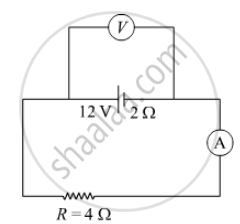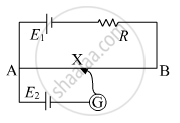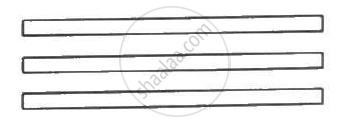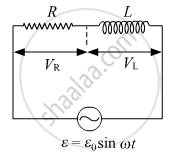Advertisements
Advertisements
प्रश्न
The potential difference applied across a given resistor is altered so that the heat produced per second increases by a factor of 9. By what factor does the applied potential difference change?
उत्तर
We know, the heat (H) produced across a resistor in time t due to flow of current (I) through it is
`H =V^2/Rt`
where, V is the potential difference applied across resistor R which gives current I.
Therefore, heat produced per second is
`H/t =V^2/R`
`⇒V^2 prop H or V prop sqrtH ` ...(i)
Now when the potential difference is altered from V to say V', then the heat produced per second increases by factor of 9
`⇒V' prop sqrt(9H)`
`or V' prop 3sqrtH` ...(ii)
Dividing (i) by (ii), we get
`(V')/V = (3sqrtH)/sqrtH`
`⇒V' = 3 V`
Hence, the potential difference changes by a factor of 3.
संबंधित प्रश्न
Define 1 volt PD.
In the figure shown, an ammeter A and a resistor of 4 Ω are connected to the terminals of the source. The emf of the source is 12 V having an internal resistance of 2 Ω. Calculate the voltmeter and ammeter readings.

In the circuit diagram given below, AB is a uniform wire of resistance 15 Ω and length 1 m. It is connected to a cell E1 of emf 2V and negligible internal resistance and a resistance R. The balance point with another cell E2 of emf 75 mV is found at 30 cm from end A. Calculate the value of R.

Draw a schematic diagram and explain the working of Van de Graff generator device.
Find the potential difference between the points A and B and between the points B and C of the figure in steady state.

The capacitance between the adjacent plates shown in figure is 50 nF. A charge of 1⋅0 µC is placed on the middle plate. (a) What will be the charge on the outer surface of the upper plate? (b) Find the potential difference developed between the upper and the middle plates.

Two capacitors of capacitance 20⋅0 pF and 50⋅0 pF are connected in series with a 6⋅00 V battery. Find (a) the potential difference across each capacitor and (b) the energy stored in each capacitor.
What will be the potential difference in the circuit when direct current is passed through the circuit?

If a positive charge moves in the direction of the electric field ______.
Assertion: Electric potential and electric potential energy are different quantities.
Reason: For a system of positive test charge and point charge electric potential energy = electric potential.
